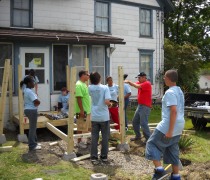By Susan Lang
Reprinted from Cornell Chronicle October 27, 2009
Almost half of all recent M.D.s and Ph.D.s in biology are women, and so are the majority of new psychologists (67 percent), veterinarians (75 percent) and dentists (70 percent). But why the lack of women mathematicians, engineers, chemists and physicists?
In the top 100 U.S. universities, only 9-15 percent of tenure-track academic positions (and less than 10 percent of full professors) in math-intensive fields are held by women, report Cornell professors Stephen J. Ceci and Wendy M. Williams.
Yet, more than one-third of the professors in the social sciences and humanities (except in economics with 16 percent) are women.
In their new book, "The Mathematics of Sex: How Biology and Society Conspire to Limit Talented Women and Girls" (Oxford University Press), Ceci and Williams examine evidence from around the world in endocrinology, economics, sociology, education, genetics and psychology about why such fields as mathematics, computer science, physics, engineering and chemistry are so lopsidedly male. They examine three classes of explanations: ability differences in mathematics and spatial ability, biases and barriers, and career/lifestyle preferences.
Their general conclusion: The imbalance in mathematically oriented careers is not due to the sex differences in mathematical and spatial ability that have been reported, or to current biases.
"Though past cohort discrepancies may be explained in such terms, because women are hired for tenure-track positions at rates roughly comparable to their proportions in the Ph.D. pools -- and more often than not, slightly above their proportions," said Ceci, the Helen L. Carr Professor of Developmental Psychology at Cornell.
Rather, he added, the single biggest reason why so few women work in these fields is because they opt out of such careers at a fairly young age.
"In surveys," Ceci said, "very few adolescent girls say they desire to be an engineer or physicist, preferring instead to be medical doctors, veterinarians and lawyers."
Although females earn a large portion of bachelor's degrees in all fields of science, including math-intensive fields (46 percent of mathematics majors are females), disproportionately fewer women enter graduate school in these fields, and fewer women who earn Ph.D.s apply for academic jobs.
Women want some job flexibility to raise children, and "the timing of child rearing coincides with the most demanding periods of their career, such as trying to get tenure or working exorbitant hours to get promoted," Ceci said.
For the same reasons, women drop out of scientific fields after entering them -- especially math and physical sciences -- at significantly higher rates than men, particularly as they advance, added co-author Williams, professor of human development.
Even in such fields as medicine, where women now make up half of graduating classes, those entering academic medicine drop out at higher rates than do their male counterparts.
"The tenure structure in academe demands that women who have children make their greatest intellectual achievements contemporaneously with their greatest physical and emotional achievements -- a feat fathers are never expected to accomplish," Williams said. "When women opt out of careers -- or segue to part-time work in them -- to have children, this is a choice men are not required to make."
The book builds on a study that Ceci, Williams and colleague Susan Barnett published earlier this year in the American Psychological Association's Psychological Bulletin (135:2), which analyzed more than 400 articles and book chapters published over 35 years on sex differences in math.
Ceci and Williams, a couple with three daughters, including one with a graduate degree in engineering, both teach in Cornell's College of Human Ecology.




